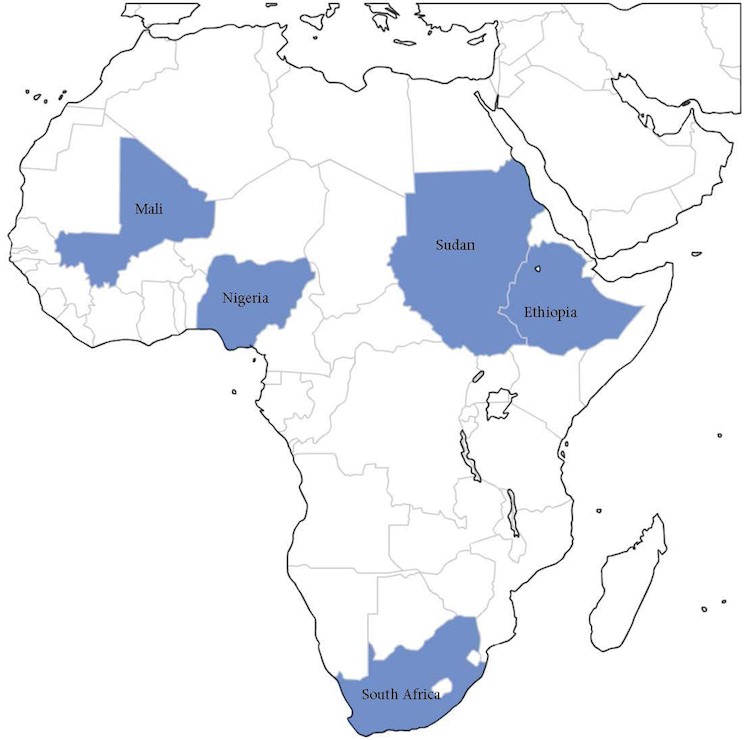Oral Presentation 20th Lancefield International Symposium on Streptococci and Streptococcal Diseases 2017
The AFROStrep Registry antad Biorepositry for Streptococcus pyogenes: the first year in South Africa (#30)
Introduction: The African group A streptococcal infection registry (the AFROStrep Study) was established to collect data on group A β-haemolytic Streptococcus (GAS), a gram-positive bacterium also known as Streptococcus pyogenes in Africa, where surveillance data on GAS are largely lacking. Launched in 2016 with a pilot project in South Africa, it aimed to provide an understanding of GAS disease on the continent. We briefly summarise below, progress on the project to date, including some preliminary results.
Methods: The AFROStrep Study is a collaborative multi-centre study of clinical, microbiological, epidemiological and molecular characteristics for GAS infection in Africa; the participating regions in Africa are shown in the figure. The AFROStrep registry comprises two components: (1) active surveillance of GAS pharyngitis cases from sentinel primary care centres (non-iGA S), and (2) passive surveillance of non-invasive and invasive GAS disease (iGAS) from diagnostic microbiology laboratories. Data were prospectively collected on a standardised questionnaire, using established case definitions. Samples, one per patient, were inoculated in sheep blood agar plates, and processed according to standard laboratory protocols. A biorepository was established to house laboratory-confirmed GAS isolates from patients. Isolates were subjected to DNA extraction to allow for emm gene characterization by molecular methods and cryo-preservation for long-term storage.

Results: The passive surveillance arm of AFROStrep commenced on 01 March 2016, with 561 isolates collected from the diagnostic laboratory over 18 months; mean age, 34 years (SD 19.4 years), % Male = 64%). Isolation sites of samples were reported as being from pus swabs n=185 (33%), aspirates n=114 (20.3%), deep tissue n=59 (10.5%) abscess n=33 (5,9%), blood n=30 (5.4%), and CSF n=6 (1%); not specified or designated as other n=134 (23.9%). Invasive samples made up 48% of the isolates with blood samples occurring mainly in patients with joint-related conditions. Of those sequenced, the emm type distribution of GAS was dominated by types 76 (17.44%), 53 (9.3%), 44, 49 and 80 (7%, respectively). Compared with non-invasive isolates, invasive isolates were dominated by types 44 (5 invasive isolates vs 1 non-invasive isolate), 53 (5 vs 3) and 76 (9 vs 6). Dominant among non-invasive isolates were types 49 (5 non-invasive vs 1 invasive), 81 (4 vs 1), 184 (3 vs 1). Compared with studies elsewhere, emm types associated with invasive disease, were absent or single isolates. Three of the dominant emm subtypes isolated in our conhort were not amongst the putative 30-valent GAS vaccine currently under development..
Discussion/Conclusion: The AFROStrep Study has managed to create a platform for epidemiological analysis of and research into streptococcal disease in Africa. The early results indicate rates of isolation of GAS higher than was anecdotally believed. We were able to provide, for the first time, the GAS emm subtypes in isolates from Africa and showed, a noticeable difference in the prevalent emm subtypes. Nevertheless, we acknowledge the low numbers of recruitment to date; definitive conclusions will have to await further molecular analysis of the remaining GAS isolates. Of concern, from the point-of-view of prevention, is that the current candidate vaccine against GAS, mostly based upon the M protein, does not include dominant emm subtypes isolated in our conhort. We believe that the AFROStrep study will help quantify the burden of GAS infection, document the prevalent strains presenting in the respective communities and, provide information that could inform the development of locally sensitive guidelines, future research programmes and policy development, all of which have the potential to improve the management of individuals with GAS infection and GAS related diseases.